What is this? #
This is a kind of “style guide” describing the methods and attitudes behind the MEGA series, when I first started writing it I described it to Massi as “a sort of internal document we can share to anyone we might want to collaborate with us writing wise on it somewhere down the road”, although I quickly admitted that this was “my thinly veiled excuse for just wanting to pen out a mission statement of sorts”.
While of course we had the kind help of many different people in making the productions, MEGA had always primarily been a collaboration between Massi and myself, with us both handling the writing, research and editorial decisions of the documentaries while he handled the production and presentation, acting as the narrator and on camera presenter. (Later, starting with MEGA: The Ukrainian Divide, I started to enter the presentation field as well.)
We both found it an interesting idea to imagine what a third person, who Massi nicknamed “Person C”, would bring to the table, saying:
who knows, with another writer I might get to produce topics I did not even think about producing
we have our interests, but what interest does Person C have?
maybe he will also create his own flavour of MEGA docs
to which I said:
exactly, the idea is basically that we could theoretically have someone bring their own niches to the table
but this document basically is like a style guide to keep them within the methods of mega, so people wouldn’t go off and write something that doesn’t fit the format
Although we both realised that Person C actually coming over to join us was very unlikely, which Massi summed up as:
let’s see who is gonna be masochistic enough to work on one of those videos with us
especially in these beginning times were the only payment I can offer is fuck and all
But even though this imaginary third person actually joining us wasn’t likely to become reality any time soon, writing to them was a useful device to explain MEGA, because if you want Person C to be a good collaborator who “fits in” with the style, they need to know both the mentality behind it and the technical background.
Which makes this quite a broad document, it goes into our mental attitude with things like journalistic ethics, bias and how to present complex issues fairly, and also more practical issues like what tools we use to write and research, how to format documents and what an appropriate runtime for a video looks like.
For that reason even though you might not be Person C, I think if you’re interested in MEGA you might find this an interesting read too, a bit of a peak behind the curtain if you like.
Something that’s worth pointing out is the examples the document points too, while it does make some references to documentaries that have been released, it also points to 2 that, at the time I’m writing this, haven’t been.
The first one is the so-called “Terror War” script or the “War on Terror series”, this is a documentary that hasn’t been released yet and won’t be for some time, it was started years ago, roughly around the same time I was making the “Truth of North Korea” script.
In January last year I recorded a version of it at the same time we were writing and recording MEGA: The Ukrainian Divide, with the idea being that it would be the next MEGA project that would release after Divide. But Divide took much longer than expected to put together, with the first episode only coming out a year later, and so plans changed, I think I’ll at some point polish it and release it in article form on the website, as a video version is a long way away with our interests turning to other projects.
The second script that’s referenced is Divide itself, only Episode 1 is out right now but there are some references in here to topics and material featured in the next 3 episodes, so if you read this it will “spoil” some subjects that come up in future episodes, but MEGA is a documentary series not a Marvel movie, so I’m just fine with that.
I only ever shared this with Massi and one of our supporters, a friend of ours who goes by “G0utBack”, you may recognise his name from the “Guiding an Audience” article, he also provided some writing assistance for The Ukrainian Divide, I wouldn’t say “G0utBack” is “Person C” as he isn’t involved with the productions beyond giving some advice and inspiration here and there, but he’s the closest person to it so far.
Anyway, I thought that rather than this document gathering virtual dust in my private Google Docs list, it would be interesting to share it here instead, hopefully it’s interesting enough to be worth reading.
I haven’t done any changes to it except for some little formatting changes but the words are all as I left them last year, that means some things won’t be up to date, like there’s an example included of a disclaimer for MEGA The Ukrainian Divide where the months are still listed as “X 2023”, since we were going to add the dates the episode finished writing and production, with X being the month we would add in once we were finished, now of course production has stretched into 2024, and we filled in the dates for the actual disclaimer as you can see in the start of Episode 1.
And of course, this hasn’t been proofread, I felt it was better not to tamper with these things and just leave them as I made them at the time.
Anyway, this background ramble has gone on long enough, here’s the article!
This document was originally written from the 5th of November to the 18th of June 2023, and first publically released (via this website) on the 7th of March 2024.
Introduction #
What is this document? #
Welcome to MEGA!

The guide for it.
This is a style guide designed to help people involved in writing for a MEGA production, giving insight into how the MEGA series is and should be written and how that can be replicated in future works.
If you haven’t heard of MEGA or been approached to work on a MEGA video, this document probably isn’t for you.
If you want to see some of the MEGA reports as a reference point, take a look at this playlist.
What is MEGA? #
MEGA is a journalistic documentary series involving (mostly long form) videos that are hosted for free on platforms like YouTube and odysee, and in a commercial format on platforms like Gumroad, it is a series produced by myself (Elwood) and co-writer and producer Massi (aka Cheecken), who hosts the series alongside other productions such as SiG (Sound Design in Games), OPINIONPIECE and [oscuro], his work is usually more video game based, but MEGA is an attempt to branch out from this and a series long in the making.
MEGA has been a concept since at least 2020 and the first documentary ( MEGA: Yeonmi and North Korea) and its accompanying paid version ( MEGA: Yeonmi and North Korea Unsanctioned) were released in January 2022, followed by a short episode, Yeonmi Park, UFOs and Fake News, in February 2022 and the second documentary The Ukraine Narratives in March 2022.
Writing Style #
Choosing topics #
MEGA is primarily a journalistic project, talking about politics, ideology and worldviews, it’s also about media analysis, discussing our world and the tools we use to learn about it, but it’s a broad series and can be about all sorts of subjects, the only real set in stone “rules” surrounding it are that it should be interesting, strange and something most people don’t know about and probably should, we like to teach people about weird shit.
It should also be relevant to the modern day in some way, we don’t see much use in reporting on things just for the sake of it, producing MEGA videos takes a long time and requires a lot of effort, so we shouldn’t waste these things on a production that isn’t useful to people, when people finish one of our videos they should have their worldview impacted in some way and they should be able to relate that to other things they hear throughout their life.
How to write #
Do not be unbiased #
Some people say journalists should be unbiased, neutral or apolitical, they shouldn’t take sides in debates and should remain impartial. With the MEGA series, we reject this idea.
Why? Because facts are not unbiased, neutral, or apolitical, when working with journalism on complex topics, even a half hour or hour long report cannot bring up all of the facts related to an issue, faced with these constraints you have to pick and choose what facts to bring up and what facts to leave out, these choices will strengthen one side of a debate and weaken another and they have to be made, we should accept this.
Does that mean in a debate we should completely shut out one side and only about the other? No, we should discuss opposing views and acknowledge that things are not black and white, and that facts can be interpreted in different ways by different people, but what we should do is take a stand, the term sometimes used for this kind of reporting is “ advocacy journalism”.
For example, our second MEGA documentary, the Ukraine Narratives, talked about the war in Ukraine, there were opposing views on this subject: One camp believed Russia’s war was justified, the other believed it wasn’t, we took our stand and stated that the war wasn’t justified, there were also views about whether the war was unprovoked or not, we took the side that it was provoked.
We came to these views through our research and analysis, this is what the slogan of the MEGA series “Boldly Truthful” means, we should do lots of research on a topic, and take a stand on the issues surrounding it based on what we’ve learned, using the research to back it up, we should do this even when the facts surrounding the topic are uncomfortable, controversial or disputed, in fact we should do it especially when the facts are in this state, because if we don’t take a stand on the issues others will take that role from us and capture the minds of audiences instead, there’s no guarantee that these people will try to be honest, you cannot combat misinformation through sitting on the fence, Massi explains our balance between factual and opinionated reporting in this way:
I think what we do writing wise is a very weird inbetween between the artistic and the “scientific”.
In drawing for instance there is the art and then there is the design. Design has rules, it has norming, it has theory behind it and it can be learned. The art, the expression part of the drawing, is intuitive and it is not bound by design. So concept art for instance is art that has been stripped of much of the expression,it isn’t about artistry, it is product design.
With the writing for MEGA we have restrictions, we need to follow “Design” in order to showcase the information in the best light possible and to not mislead the viewer. If we get carried away with wordsmithing, we may mislead and manipulate the viewer in a way we have not intended. The difficulty in this kind of writing is using wordsmithery just enough to present the information accurately, but also to make it entertaining enough for someone to listen.
It is a combination of two completely different thought processes, you have to think about rules but also the expression of the words, if MEGA was like a poem or a fiction book, it would have all the creative expression, but it would lack the scientific part and if there is an area where expression cannot overtake design, it is this specific kind of writing.
I see videos as explicitly manipulative, since they can easily have narratives. If we remove the narratives and expressions, we are left with reviews, and rattling off facts, so people should pay attention to how they manipulate instead of pretending like their work isn’t manipulative at all, or “purely objective”.
We openly explain our approach to reporting in the disclaimers that appear at the beginning of our documentaries, we started including as part of our disclaimer format with our documentary MEGA - The Ukrainian Divide:
We have aimed to make this documentary as factual and accurate as possible, but it is not and does not claim to be unbiased or neutral, it represents a combination of evidence based research and our subjective personal opinions.
On video length #
There is no upper or lower limit to how long a script can be, as long as it serves its main purpose, explaining its topic and the issues and facts surrounding it, in one report this took less than 5 minutes, another an hour and 22 minutes, so there’s room for a wide range.
The only guideline is that a single video should generally only last a max of an hour or hour and a half, something around that length, this doesn’t mean that you can’t work on scripts much longer than this, you can, but they should be formatted as a series of multi part videos rather than a single video; You can include all parts of this format in a single script either way, but multi part videos should have their own introductions and conclusions included in the script rather than being written as a single video then arbitrarily chopped into pieces last minute.
In general, our aim when deciding length is to provide all the necessary information and context an audience member should know in the shortest amount of time possible, as our range demonstrates, sometimes it may take hours to fulfil that purpose, other times it might only take a few minutes, the length will usually be defined by how extensive a topic is, the broader the topic the more context may be required, and the longer the production becomes as a result.
Consider context and relevance #
We don’t have the resources to make a 10+ hour documentary like The Vietnam War, or the kind of audience that would watch a production of that length, so while we do aim to show audiences the big picture, we can’t show the full picture, to summarise the huge topics we cover on MEGA with every piece of info imaginable retained we would have to create productions with a runtime of days or weeks.
As a result of this, we have to pick and choose what context to include and what can be left out, and this is a very important series of decisions to make because it can influence the viewer’s perspective, to make these judgement calls we have to consider the relevance of the info we might want to include.
A strong example of this can be found in the Terror War script, where we had to handle the sensitive matter of war crimes instances, in earlier versions of the Iraq portion of the script numerous references to war crimes committed by the US led coalition during the invasion of Iraq were mentioned, many of these instances were later cut from the script.
This was not because we aimed to cover up instances of war crimes in any way, but because we had to consider their impact, while the script mentioned US war crimes, it did not describe the fact that Iraqi forces were also involved in war crimes during events discussed in the script (the Iran-Iraq War, the invasion of Kuwait and invasion of Iraq), this could have the unintended impact of making the Iraqi forces appear less involved in atrocities and immoral practices than US forces, which was not accurate.
To correct this, we could either remove the mentions of US practices or add discussions surrounding Iraqi practices, the second option would add unnecessary information not relevant to the video topic, so we opted for the first option, while war crimes were still discussed, it was in a more limited format referring to instances connected with the spread of terrorism.
It goes without saying that every issue if this kind should be decided on a case by case basis, but the usual criteria is this:
-
Is the context relevant to the main topic of the script?
-
Will the context give a more accurate impression of the subjects?
If the answer to either of these questions is no, there is likely a justification for cutting context, in an ideal production we would have the runtime to include every bit of context possible, but when we cover such complicated topics this often isn’t the case, and so to show a more accurate explanation of a subject matter sometimes what we leave out is as important as what we include.
In a similar vein, we have to consider this kind of context when discussing hypocrisy, calling out hypocrisy is often a very important thing, but we have to be careful that it doesn’t devolve into “whataboutism”. “whataboutism” is essentially when someone responds to an accusation with a counter-accusation, instead of an actual response, to explain this here’s an example.
Let’s say we have 2 people in an orchard, they each have an apple tree, they each go to each other’s trees and steal an apple.
Person A says: “Hey, you stole my apple!”
Person B says: “So? You stole my apple too!”
This is an example of whataboutism, the fact that person A stole an apple, doesn’t somehow lessen the fact that person B stole an apple, the answer to this problem is, don’t steal apples.
But let’s take the same scenario, in a different context, same orchard, same theft, but here’s the conversation.
Person A says: “Hey, you stole my apple! I’m gonna hit you for that!”
Person B says: “What? How can you hit me for stealing your apple? You stole mine too!”
This could be confused for whataboutism, but it isn’t, it’s a justified point, person B isn’t justifying their theft of the apple, they’re rejecting a hypocritical punishment.
Essentially, hypocrisy is not a point to use to defend someone’s behaviour (the theft), it is a point to use to attack hypocritical justifications (the attack threat) or principles, we can look at several examples in our Ukrainian Divide script to demonstrate.
Russia has intervened in several conflicts in the neighbouring countries of Georgia and Moldova, supporting separatist groups rebelling for independence, they justified this by saying these groups deserved self-determination, the right to choose between independence and unity with their home countries for themselves.
However Russia during the same period also intervened against separatists in their own country, in a region called Chechnya, and reintegrated them through force, this was a double standard we pointed it out, because it showed that Russia’s justification was hypocritical, they were supporting self determination when it suited them, and when it didn’t, they opposed it. We were attacking Russia’s argument for their interventionism because it was hypocritical, and this was important to prove that their actions were not benevolent, but they were instead self-serving, we did not try to excuse the behaviour of any other parties to these conflicts by making this point.
We rejected this argument, because while it did prove the USA was being self-serving and hypocritical by attacking Russia for its actions, the argument wasn’t about whether the US was hypocritical or not, it was about whether Russia was justified, the point was irrelevant and deflecting from the actual topic, the legality of Russia’s intervention, classic whataboutism.
We didn’t do this to attack a hypocritical justification, because the Media Freedom Coalition didn’t use Russia’s actions to call for Russian media bans in retaliation, but we also weren’t pointing out the hypocrisy to defend the media bans of Russia, we were instead attacking a hypocritical principle, the MFC had condemned restrictions on the media and called for media freedom, while its members were restricting media freedom themselves. Because we weren’t using this point to defend Russia, this was not whataboutism, we condemned the media suppression carried out by both Russia and EU nations.
Calling out this hypocrisy didn’t make much of a point in itself, but it tied into our wider point about the need for media and internet freedom, and our argument that governments that are party to the information war, using tactics like these bans, should not be the ones acting as its referees through regulation.
Writing Tools #
Google Docs #
We currently use Google Docs for our scripts, this is because it can be edited by multiple writers simultaneously allowing for smoother collaboration and oversight, meaning everyone involved in a production is on the same page.
Does that mean you have to use Google Docs from the get go? No, you can start writing wherever you like, some places scripts have been started on before range from offline documents made in LibreOffice to physical documents made on an old typewriter, but at some point before the script is finished it should be put onto Google Docs so it can be worked on collaboratively.
Research Tools #
Browser Choice - Vivaldi #
While we acknowledge that our work can’t be unbiased due to factors like editing decisions and emphasis, and that being completely unbiased isn’t an ideal to work towards, there are some forms of bias we should work to lessen, one of these is the bias of search results.
When doing research on a topic we naturally will get a lot of that from the internet and by extension, from our search engine of choice, but search engines don’t necessarily always show what we want or need to see.
This is something we talked about for our Ukrainian Divide project, where we noted that search engines were carrying out various forms of censorship, ranging from outright blocking results to “deranking” them to make them harder to see:
To get wide ranging, quality research we need to be able to counteract these censorship tactics, and one way that can be done is browser choice.
We use a browser called Vivaldi, which is similar to Google Chrome but with added built in privacy features like tracker blockers and extra customisability, but its true value for us in terms of research is its ability to easily switch between search engines.
In most browsers, you have a search bar at the top, you pick the search engine for it and that’s it, on Chrome the default will be Google, on Microsoft Edge it will be Bing, so on and so on, while you can change the browser your search bar uses, or manually search for another engine and go from there (like Googling “Bing” to then search with Bing), this is inconvenient, what Vivaldi does is offer a second search bar where you can quickly switch between search engines using a drop down menu:
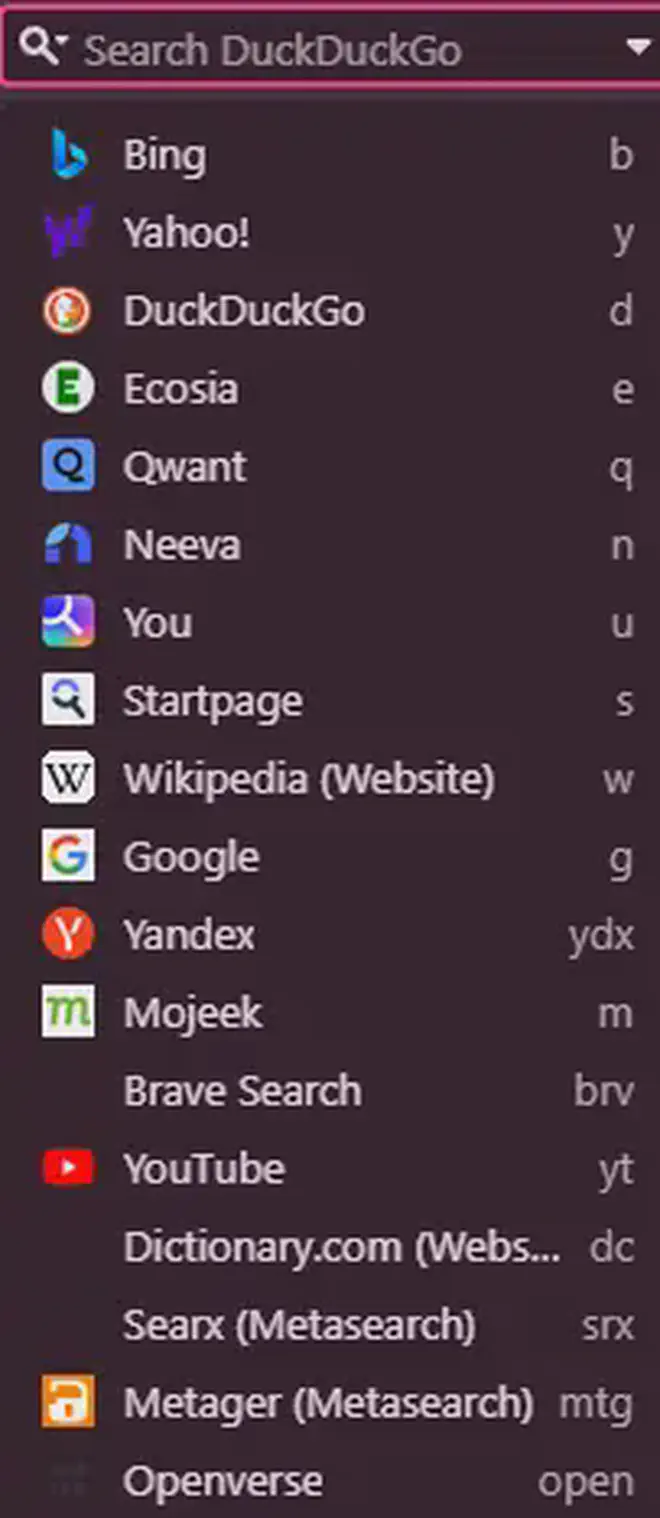
And you can easily add as many search engines to this menu as you like, this means that while we can’t totally remove search engine filters, we can choose the filters we see through, which is an invaluable tool for searching for info a certain engine might choose not to show you, or choose to devalue, as explained in another quote from the Ukrainian Divide series:
even if we can’t totally remove these filters that meddle with our search results, we can go for the next best option: Customising and switching between these filters to find what we want, and see what different engines want to show us, we don’t have to be manipulated by the tools we use to seek information, they can still be ours to control
While your choice of browser is ultimately up to you, because of this utility we strongly recommend Vivaldi.
RSS #
Another way you can get access to information is through RSS, what is RSS you might ask? Well, here’s an explanation:
RSS stands for Really Simple Syndication. It refers to files easily read by a computer called XML files that automatically update information.
This information is fetched by a user’s RSS feed reader that converts the files and the latest updates from websites into an easy to read format. An RSS feed takes the headlines, summaries, and update notices, and then links back to articles on your favorite website’s page.
This content is distributed in real time, so that the top results on the RSS feed are always the latest published content for a website.”
Essentially RSS feeds are a bit like mailing lists, you subscribe to them and then anything published in that feed will be sent to you, that feed could be a certain content creator, a website, or just a specific category of a site, the advantage of this is that you can receive lots of news without having to rely on an algorithm or on slow manual scrolling through webpages, once you add an outlet’s feed, you get a simple up to date list of everything they publish.
Vivaldi has its own built-in RSS reader, but you can also use external programs for reading RSS feeds, like RSS Guard.
And despite being mostly unheard of by the public these days, most outlets will still offer up to date RSS feeds to this day, that includes news outlets, random websites and even governments, making it a great resource.
It’s important to note that RSS isn’t a replacement or substitute to regular searching, because of course it relies on you adding the feeds, you won’t get material from anything you’re not subscribed to, so you still need to do lots of searching to find info from outlets you might not have heard of before.
Wayback Machine #
When doing our research we also have deal with the fact that over time, resources are made less accessible or outright deleted, but the good thing is that the Internet Archive’s Wayback Machine lets anyone archive a webpage at any time, this is a very useful tool, and we utilise it a lot to maintain access to sources, just check our sources lists and see how many sources are tagged with “- via Wayback Machine” “(archive.org)” or some other variant.
If you come across a source you’re struggling to get access too, try pasting the link into Wayback and see if that gets you the results you need, it’s also sometimes worth archiving pages yourself as well, if you get access to a page you think might be deleted later, whether that’s a social media post, an article, or even an entire website.
Obsidian #
Obsidian allows you create repositories called “Vaults” that act like a kind of internal wiki, you can create individual pages and then link them together by backlinks and groupings like folders or tags, it also gives you a graph view where you can see all of your individual pages and the connections they have based on the backlinks, here’s an example from a repo we used while making the Ukrainian Divide documentary, mapping out various far-right groups involved in the Ukraine conflict:
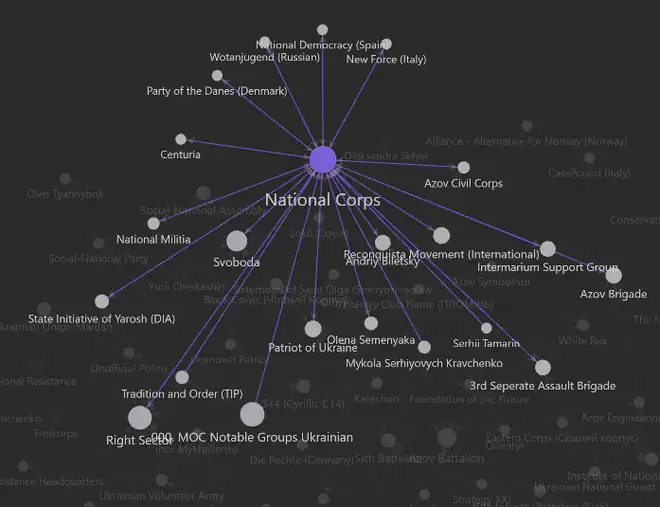
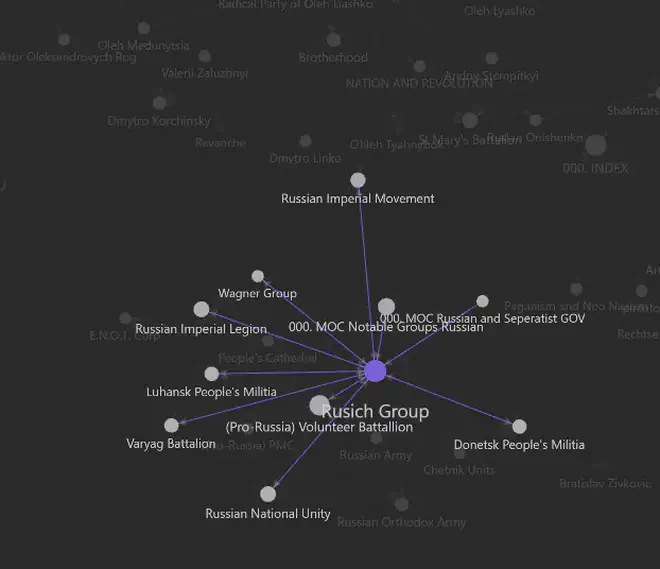
This is a really useful resource for working on large scale research fields, either on a particular topic or an entire project, not only because it allows you to create an internal wiki to easily keep track of any relevant details, but also because its visualisation provides a sense of scale.
Ethics Code #
Explanation #
Many journalistic bodies or outlets have a sort of code or statement on the ethics of their work, these can vary from outlet to outlet but they usually boil down to ensuring integrity in reporting, I’ve decided to write down our own ethics code that defines how the platform of these documentaries should be used.
This code I’ve written is less of a regulation and more of a statement on our existing approach, but it is something to consider and follow in the making of the documentaries.
Code #
-
Use the platform to create clarity, not confusion.
-
Do not report claims you know to be false unless it is for the purpose of scrutinising them.
-
Never place any of the “need to know” of a story (such as facts, context or sourcing) behind a paywall.
-
Include any affiliations or sponsorships that may bias the reporting in a clear disclaimer.
-
In the case of interviews, respect the wishes of the interviewee to be identified or not.
Inspiration #
In writing these guidelines I took some inspiration from the UK’s National Union of Journalists code.
But another strong reference point, more specific to our form of journalism, would be this series of guidelines raised by Canadian advocacy journalist Sue Careless to the Canadian Association of Journalists (which I found cited on the Wiki advocacy journalism page) this is a slimmed down bullet point summary of her ideas (but of course, feel free to read her full commentary yourself):
-
Advocacy journals - sometimes called alternative publications - have a declared bias, a publicly acknowledged editorial point of view.
-
Being an advocate journalist is not the same as being an activist. No matter how dear a cause is to a journalist’s heart, there are lines which should never be crossed by a professional journalist.
-
If you only spout slogans and cliches, and rant and rave then you are not doing honest journalism. You need to articulate complex issues clearly and carefully.
-
Can a journalist have a declared bias and still practice journalism in a professional manner? Yes. In fact you may be seen as even more credible if your perspective is acknowledged up front.
-
A journalist writing for the advocacy press should practice the same skills as any journalist. You don’t fabricate or falsify.
-
You shouldn’t take something wildly out of context or treat an extremely nuanced subject as a sound bite. There must be a general fairness and thoroughness. Verify your facts and quotes. Use multiple sources and try to cite neutral sources for statistics.
-
You use your eyes and ears when you are news gathering. If you are covering a protest and a demonstrator hits a police officer or shouts profanities, you are obliged as a journalist to report those facts, embarrassing though they may be to a cause you personally support.
-
A good journalist must play devil’s advocate. You must argue against your own convictions. In an interview, you still have to ask the hard questions of possible heroes, the tough questions, even of the people you admire. You are not writing public relations for them and they will not be vetting your piece.
-
You will be far more credible if you write with a critical edge. You cannot view your cause or community through rose-coloured glasses.
-
In advocacy journalism you must have the humility to listen carefully and accurately to those you would speak for, and not arrogantly assume you know what will be said or thought or argued.
-
You may believe something in theory or in principle, but how does it play out in practice? I must listen with respect to those who are and who make some incredibly courageous choices in the midst of conflicting circumstances.
-
Advocacy journalism does not generally give equal time to opponents, but neither does the mainstream press.
-
Even when a juicy story or outrageous statement emerges from your opponents, you don’t rush to print it until it is confirmed.
Disclaimer Format #
Structure #
Before each documentary begins, we display a disclaimer initially this was just for the purposes of age ratings, but now it’s used for clarifying putting the documentary in context, the format of the disclaimer should be written like this.
Section 0 (only add if applicable) - Disclose what content included at the time of writing may be out of date by the time of release.
Section 1 - Disclose any affiliations or sponsorships that may bias the reporting, or the lack of these affiliations/sponsorships.
Section 2 - Bias disclosure (should always read the same in every disclaimer):
We have aimed to make this documentary as factual and accurate as possible, but it is not and does not claim to be unbiased or neutral, it represents a combination of evidence based research and our subjective personal opinions.
Section 3 - Source location and source use clarification, the first part of this can vary based on where we host our sources, but the second part about the way we use sources should always read the same in every disclaimer:
All sources used for the production will be cited throughout the video, in the credits and in the description.
Our use of an outlet as a source does not necessarily mean we agree with all of its views or contents.
The disclaimer can be written at any time before the script goes into production, but it should always be included and shown in the final production.
Example #
The script for this production was written between September 2022 and X 2023, and recorded between January and X 2023; As a result, some details related to current events may be out of date at the time of release.
This is an independent production, it is not sponsored by any organisations: Governmental or non-governmental.
We have aimed to make this documentary as factual and accurate as possible, but it is not and does not claim to be unbiased or neutral, it represents a combination of evidence based research and our subjective personal opinions.
All sources used for the production will be cited throughout the video, in the credits and in the description.
Our use of an outlet as a source does not necessarily mean we agree with all of its views or contents.
- Ukrainian Divide disclaimer
Sources #
Why you should add sources #
In a documentary series like MEGA, we will talk about controversial subjects, subjects where there are lots of competing views and interpretations of the subject.
People watching our documentaries may come in with their own preconceptions, their own opinions about the topic that might not be the same as ours.
So when we make claims in our videos that people might question, or debate, we don’t want people to think we’re just making things up, we want to show that we’ve done our homework and that when we make claims, there’s research behind them.
So what do we do? When we make claims, we source them.
What is a source?
In journalism, a source is a person, publication, or knowledge other record or document that gives timely information.
My source for that claim, by the way, is this page from Wikipedia:
https://en.wikipedia.org/wiki/Source_(journalism)
Much of the MEGA series is about debunking narratives on issues, helping people understand that our world is not black and white, and showing that heroism is often based on myth, that things are very murky and painted with grey.
Doing that is a very important thing, but once people come to understand that their worldview is filled with misinformation or misunderstandings, they become vulnerable to even further misinformation, if you destroy someone’s narrative they may jump to whatever alternative first comes into view, whether that narrative has more truth to it than the last, or not.
Sourcing and committed research is what separates a strong, educational narrative and worldview from misinformation. If someone tells you that everything you know is wrong, how can you tell what they know is right? You can tell because you can see their research and check what they have to say for yourself, this is what makes sourcing so important, it’s a window into our research process for our audience.
When to use sources #
You don’t need to source literally everything in your script, because that would make it a mess of cluttered links and web pages that would be horrible to read.
If something you’ve written in a script is likely to be questioned by the average viewer, that is when you should source it, if it isn’t likely to be questioned, you don’t need to source it.
For example, if I wrote “Berlin, the capital of Germany” in my script for some reason, I don’t need to source that, because the average viewer will know that this is a fact, or even if they don’t know much about geography, they’re not very likely to assume I’m lying or trying to mislead them, so I don’t have any reason why I should need to prove it to them.
However, let’s say we live in an alternate world where, for whatever reason, a lot of people are sceptical about Berlin being the capital of Germany, maybe there’s a popular myth that the capital is actually a city like Bonn or Hamburg for example, and a lot of people actually believe it, then I might actually want to add a source to my quote “Berlin, the capital of Germany”.
This way, if one of our myth believers watches the video and says “Hey, wait a minute, that’s not true! This fraud of a journalist knows nothing about Germany!”, I can show that as a journalist, I actually do know what I’m talking about after all, the source backs up my German knowledge credentials.
Adding sources to a script #
When you want to add a source to a part of a script, there are 2 ways to do it, as a hyperlink or a comment.
To add a source as a comment, highlight the text you want to add the source to and instead click on this icon:
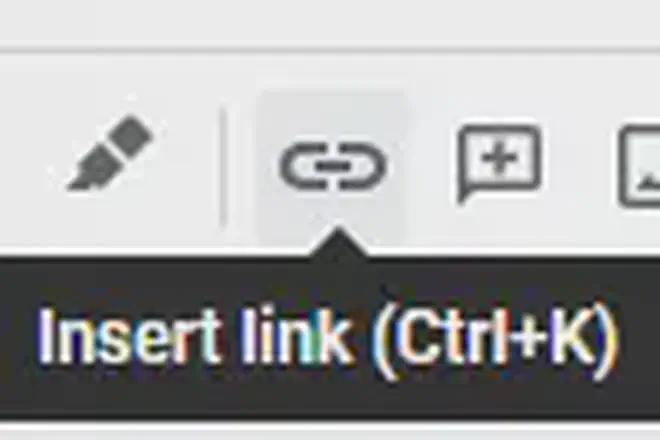
With Hyperlinks you can link a whole page, like this, or you can link a selected part from a page, like this.
The first is easy, you just copy the link at the top of the page, to link a selected part, highlight the part of the text you want, right click and then click “copy link to highlight”.

To add a source as a comment, highlight the text you want to add the source to and instead click on this icon:
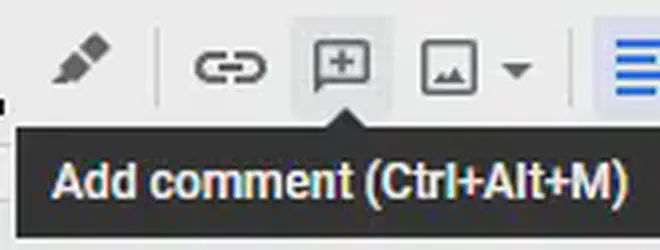
Then write your comment.
Hyperlinks should be your default for adding sources, using comments is usually for two reasons
-
You want to add some more detail about the source while citing it (for example, why you’ve decided to add it)
-
You want to only link to a selected part, but the source doesn’t let you right click and copy a highlighted part (for example, the source is a picture of some text, rather than text in a webpage format)
Let’s say I’m adding a comment source for the second reason, it will look like this.

Making a sources list #
After adding your source to the part of the script you want it on, your job isn’t done. Of course, the average viewer of a video can’t read the script, and even if they could they might not have the time or interest to, so they won’t see the sources you’ve added.
As far as they know, the claim you made doesn’t have a source, even if there’s one on the script.
For this reason at the end of MEGA scripts, we have a list of sources that appears at the very bottom of the script, like this:

See all that? Underneath the script, there’s a whole section dedicated just to sources.
This is for 2 reasons
-
It means we can easily copy the list, and put it wherever we want, so we have somewhere to direct people to if they ask for the video’s sources
-
This list will be in the credits of the video, after all the other credits, so people can see everything is sourced
As you can see, the list of sources is by topic, for example there are sources on Neo Nazis fighting in Ukraine, then we further split that into claims of Nazis fighting for the Pro-Ukraine side, and the Pro-Russia side.
This makes it easier for us, and for other people reading these lists, to know what the sources are for, if we just dumped a list of weblinks it wouldn’t really help people with understanding what source is used for what claim.
These topics are listed by the order the sources are references by in the script, and the links used as sources for each of these topics are ordered in the same way, if they are used in multiple parts of a script (say, you make a claim in a video, source it, then refer to that claim and source way later in a video) don’t repeat the topics or links, just order it from the first time it appeared in the script.
When adding a source, it should look like this:
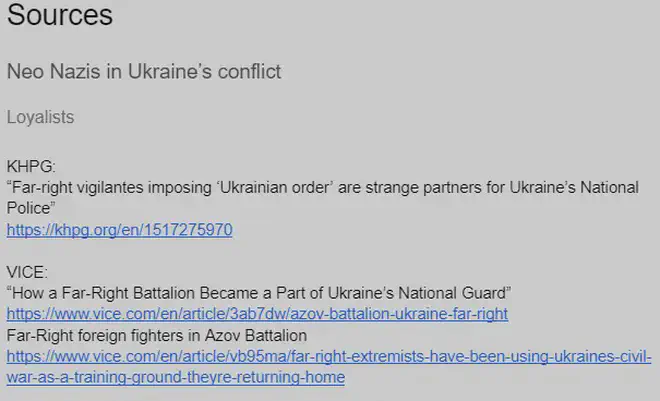
The format is
-
Name of the Source (the writer/organisation that created it)
-
The title of the Source (book name, article headline, page name, etc etc) in quote marks
-
Then the link
Alongside the source name, you can also include “Relevant Stakeholders” in brackets next to the name, according to our Relevant Stakeholders policy (see “Relevant Stakeholders” in the contents list for more detail), some examples of this:


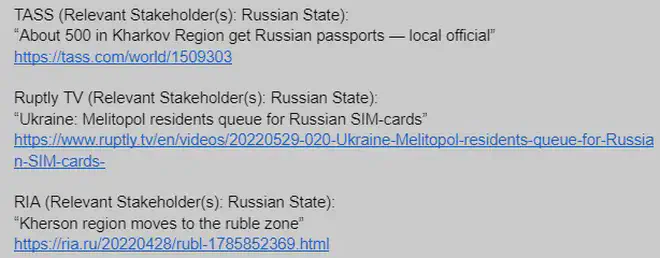
If you hyperlinked a specific quote, rather than a whole page, after this format you should add this on:

Under the link, you put in brackets “specific sections” and then you add all of the specific parts you chose to highlight for sources.
If you added a section as a comment instead, because you couldn’t get a highlighted link, just write the quote itself.
When you do all of this is up to you, you can finish a script and then add the sources list after, or you can just add the list and the topics as you go along, the second is more recommended as it will feel more like a natural part of working on a script rather than busywork at the end.
Reliability of Sources #
Avoid an echo chamber - Using unconventional sources #
While our documentaries are not unbiased or neutral, and are agenda based, we shouldn’t let our agenda be decided by what we want to hear, it should be decided by the facts of the case, this means that avoiding confirmation bias is very important, we shouldn’t choose to cite or read from a certain news platform more often than another because we find it more agreeable, in fact sometimes it’s better to do the exact opposite.
Here’s an example, the “Radio Free” media umbrella. This umbrella of news organisations (Radio Free Europe, Radio Free Asia, etc etc) is owned by the U.S. Agency for Global Media, a department of the US government, and was once also bankrolled by the CIA, as you can imagine this makes it pretty biased towards the US perspective.
So why would we ever cite a group like this as a source? Well, journalists are not monoliths, and a source having a bias doesn’t mean it’s always unreliable, so sometimes they can put some sound, useful reporting.
Take for example this piece, which remarked on Ukraine’s struggles to control radical paramilitary groups, we used this source in our Ukrainian Divide series, it contained links to other reports, detailed analysis and lots of quotations, and when cross referencing this story with others reporting on the topic it was fairly consistent with them, which gave us the impression it was a reliable source to showcase and use.
Given that our political episodes of MEGA tend to have an agenda critical of the US government, using a source connected and sympathetic to that government can be a valuable addition, as it’s a source that clearly doesn’t have an ulterior motive to validate our agenda.
Using sources like these also shows that we are taking in info from a wide range of sources, rather than just sticking to one news org that has a track record of being on our wavelength, showing that we formed our messaging as we looked into an issue (rather than starting with the messaging, finding the research that supports it and discarding everything else) shows we are making a serious effort as journalists, even if our style and methodology is somewhat unconventional, it’s also just generally good to avoid building up a bubble or echo chamber of “trusted” vs “non trusted” outlets, reporting just isn’t that simple.
Example: Government sources #
When deciding whether to use sources, consider the motive of the person behind them.
What a source says isn’t the only important thing, but why it’s said. A classic example of this is using a government as a source.
As it turns out, governments have a habit of being economical with the truth, but there’s a difference between what governments say in public and what they say in private.
An example is the MEGA War on Terror series, this series uses government documents as sources, take like one called “Reflections on Soviet Intervention in Afghanistan”

Here it is being used as a source in the script, backing up the script’s claims of what a CIA operation, Operation Cyclone, was all about:

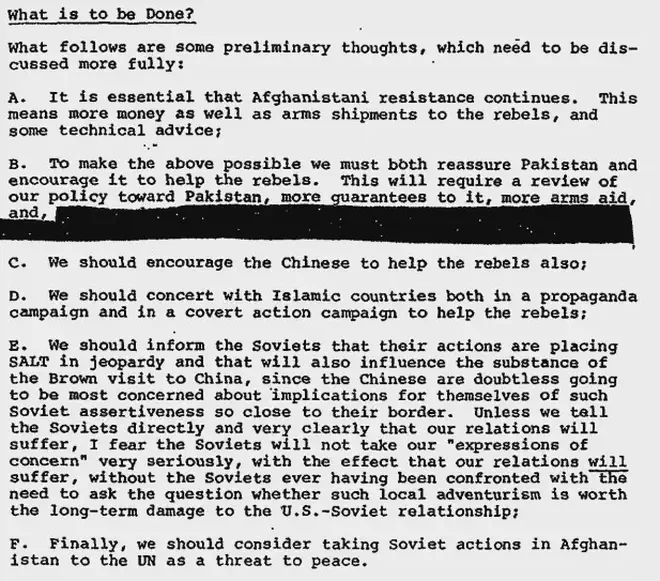
Why can we trust that this document is accurately describing the US government’s plans? Because when it was written, it was a secret, private document, not a public statement. It’s public now, but that’s because it’s been declassified, if it was a public statement meant to be read by a much wider audience we would take these claims with more skepticism.
The person writing this document (the President’s National Security Advisor) has no motivation to lie to the person the document is for (the President) about what the CIA will do, and the things he is describing (keeping the Afghan resistance afloat, encouraging China to aid the Afghan resistance, etc etc) later did actually happen, something that has been publicly acknowledged so we can use it as a good source.
But remember, while considering motive is important we should ultimately judge a source by its contents, not by who it came from, information quality is the most important factor.
Wikipedia is a source #
But not in the way you think.
“Wikipedia said so” isn’t a source, as many people have rightly pointed out anyone can write on Wikipedia and edit articles there, it isn’t a total free for all as many pages (especially on important or hotly contested topics) are moderated, but anyone with any sort of bias can edit Wikipedia claims and insert claims that may or may not be accurate.
However, Wikipedia pages offer ways for you to check if their claims are accurate, citations.
Here’s an example, the page for World War 2: https://en.wikipedia.org/wiki/World_War_II
If I want to know when World War 2 started, I can read this:

I don’t just believe this is true because it’s on Wikipedia, I believe it because there’s a citation, you see those blue markers with a 2 and a 3 on them?
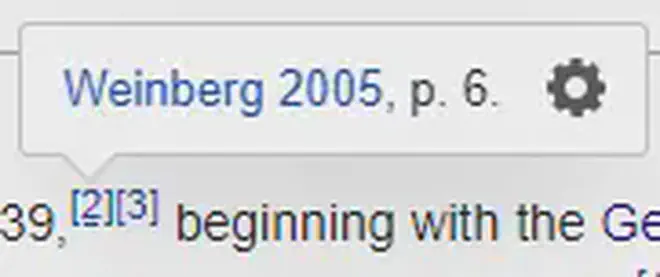

Hover over them and you will find citations, these citations can link to books, but also to web articles and other kinds of sources.
So it’s perfectly legitimate to use Wikipedia for research, but if you want to use something you’ve seen on Wikipedia as a source, have a look at the citation and see if it’s a reliable source, if you can it’s better to read the citation (the book page, linked article, etc etc) and use that as your source instead of the Wikipedia page, as citing the original source for your information is better than citing a second or third hand account.
You should also be careful to check that a Wikipedia page or summary is not mischaracterising what their source says, because that can sometimes happen, for example we can look at how Sue Careless’ statements about advocacy journalism were summarised by Wikipedia and what she actually said, one of the points on Wiki’s summary was:
- Make use of neutral sources to establish facts.
But that’s not what she actually said, what she actually said was:
You shouldn’t take something wildly out of context or treat an extremely nuanced subject as a sound bite. There must be a general fairness and thoroughness. Verify your facts and quotes. Use multiple sources and try to cite neutral sources for statistics.
It might seem nitpicky, but there’s a difference between “use neutral sources to establish facts” and “verify your facts, use multiple sources, and try to use neutral sources for statistics”.
Sticking to neutrality for getting statistics is a reasonable thing to aim for, while sticking to neutrality for overall reporting is unrealistic, neutral sources on opinionated topics can be hard to come by.
This misrepresentation was actually where I first heard of Careless’ statements, and it almost put me off from using them as an example for our ethics code, but when I read what she actually said, it was something sounding much more reasonable.
So, treat Wikipedia as a source of information, but not blindly.
Is adding sources worthwhile? #
Yes.
It’s true that lots of people will ignore them, some people won’t watch til the credits or look for the list of sources online, either because they believe what we say without needing proof, or because they don’t believe what we say and they’ll never be convinced, but it’s still important to add these sources.
Sourcing your work shows that as a journalist you have done research on the topic, and are making effort to prove your claims, even if a lot of people won’t look at the proof, it’s better that you have the proof anyhow, because that way the people who do look won’t be led to believe you’re just making things up for the fun of it, or because you want to brainwash people.
Having source material allows our audience to do wider reading on the topics we cover, and that wider reading is very important, because by supplying it we can encourage the audience not to take our word for it, and to instead judge for themselves if we’ve done a good job with our reporting.
“Relevant Stakeholders” - Transparency #
Policy #
Starting with our MEGA - Ukrainian Divide script we introduced our “Relevant Stakeholders” policy to our source listing, the policy is as follows:
Relevant Stakeholder Criteria: A person/organisation may be labelled as a source’s “Relevant Stakeholder” if the outlet’s funding is majority provided/facilitated by the stakeholder, or it is owned by the stakeholder.
Explanation #
This policy is designed to disclose ownerships we think might be relevant to the audience in our sourcing, originally it was intended to resolve the issue of labelling state affiliated media outlets, we were unsure whether or not to label these outlets in our sourcing, or what labelling to use, we originally planned to use the term “state-affiliated media”, but since that term provoked controversy when it was applied equally to outlets from both the Western world alongside countries like Russia, China and Iran, we decided to go with the less charged “Relevant Stakeholder” label, this label also allows us to disclose other kinds of interests, like corporate interests.
This policy is important because it gives audiences a transparent look into the potential bias behind the sources we use, we should always use sources based on the quality of information, not the nature of the person/organisation providing it, but these disclosures are still key to being upfront with our audience about where we get our reporting from.
State Media vs “Public Broadcasting” #
The difference between “public broadcasting” and “state media” is usually only a semantic one rather than a practical one, while state media outlets are funded by tax money, “public broadcasters” are said to be funded by “licence fees”.
However, a licence fee is a tax in all but name in practice, TV licence fees are not voluntary and refusing to pay them is a crime, just like any other tax, and citizens have to pay these fees even if they don’t watch the content they’re paying for, for example (at the time of writing) in the UK you have to pay the licence fee if you watch live television, even if the live TV you watch has nothing to do with the content of public broadcasters, in Germany you have to pay even if you don’t watch TV at all.
This is why we include “facilitated” as part of the stakeholder’s policy, while a licence fee isn’t directly paid to a state body, it is a tax and the law compels you to pay it, if you decide not to the institutions of the state (the courts and the police) will force you to do so or punish you, either through fines or prison terms, for this reason we still consider the “British State” to be a stakeholder of BBC News, just like we consider the “Russian State” to be a stakeholder of Russia Today.
However, not every “public broadcaster” should be considered “state media” and have the state labelled as its stakeholder as a result, some “public broadcasters” like NPR in the US or ITV (legally known as “Channel 3” in the UK) are technically public broadcasters, but are not primarily funded through licence fees, Channel 3 is mostly funded by advertising and NPR is mostly funded by a mix of advertising and voluntary donations.
Relevancy Criteria #
Not every owner of a source needs to be or should be disclosed, we don’t want to clutter our sourcing with these labels, relevancy should decided be based on possible conflicts of interest, for example we decided to label Scott Trust Limited - owner of the “Guardian Media Group” as a Relevant Stakeholder because it wasn’t just the owner of the Guardian, but of other media outlets such as The Observer, if the GMG simply owned The Guardian, that would be less justifiable for a label.
In general, media companies should be labelled if they control a range of outlets, other interests like corporate or state affiliation should always be labelled if they match the policy above.
Changelog #
- Edit 1 - 11/03/24 - Fixed missing images
- Edit 2 - 30/05/24 - Hyperlinked Massi’s contributor page
- Edit 3 - 27/08/25 - Added links to Ukrainian Divide where mentioned, I did consider not doing this to stick with my original intent to not tamper with the Guide, leaving it as a history piece (the Divide links weren’t in the guide when it was made since Divide wasn’t out yet, releasing around a year and a half later) but ultimately decided to include them so readers can see the examples in context if they want to
